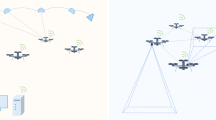Abstract
Big cities and growing industrial areas bring high risk of different kinds of pollutions which would implicate to the quality of life of the society. Discovering and monitoring of polluted areas using autonomous mobile robots is nowadays a frequently considered solution concerning both environmental and human safety problems. Being part of a distributed control system, such robots can help to improve the efficiency of the existing conventional pollution prevention systems. On the other hand, during the last decade, wireless sensor networks (WSN) have provoked the interest of specialists from different areas by imposing a large number of theoretical and practical challenges related to their implementation. This paper attempts to deal with both issues by presenting a possible way for building robotized WSNs that can be suitable for solving different environmental monitoring tasks. The goal is to transform the WSN into an adaptive sensor system with intelligent behavior that can be used to discover and track spots or areas where given monitored environmental parameters violate defined thresholds. The inclusion of robotized agents into the WSN structure can provide additional flexibility with respect to the installation of the network sensors and allow reliable information gathering and transfer. The proposed algorithmic methods have been tested on a pre-built laboratory prototype of a robotized WSN. The robotized agents (mobile network nodes) have been built using iRobot Create mobile platforms that are additionally equipped with a single-chip computers Gumstix Verdex pro TM XL6P with various expansion modules.













Similar content being viewed by others
References
Ahmed S, Shakev N, Milusheva L, Topalov A (2015) Neural net tracking control of a mobile platform in robotized wireless sensor networks. In: Proceedings of IEEE international workshop of ECMSM, 22–24 June, Liberec, Czech Republic, pp 105–110
Casbeer D, Kingston D, Beard R, Mclain T, Li S, Mehra R (2006) Cooperative forest fire surveillance using a team of small unmanned air vehicles. Int J Syst Sci 37(6):351–360
Clark J, Fierro R (2007) Mobile robotic sensors for perimeter detection and tracking. ISA Trans 46:3–13
Cruz D, McClintock J, Perteet B, Orqueda O, Cao Y, Fierro R (2007) Decentralized cooperative control—a multivehicle platform for research in networked embedded systems. IEEE Control Syst Mag 27(3):58–78
Quanser Real-Time Control Software (QUARC) (2013) Quanser Consulting Ltd
Zhang G, Fricke GK, Garg DP (2013) Spill detection and perimeter surveillance via distributed swarming agents. IEEE ASME Trans Mechatron 18(1):121–129
Acknowledgements
The authors gratefully acknowledge the financial support provided within the Ministry of Education and Science of Bulgaria Research Fund Projects FNI I 02-6/2014 and FNI M 07-03/2016.
Author information
Authors and Affiliations
Corresponding author
Rights and permissions
About this article
Cite this article
Ahmed, S.A., Popov, V.L., Topalov, A.V. et al. Environmental monitoring using a robotized wireless sensor network. AI & Soc 33, 207–214 (2018). https://doi.org/10.1007/s00146-018-0815-y
Received:
Accepted:
Published:
Issue Date:
DOI: https://doi.org/10.1007/s00146-018-0815-y




